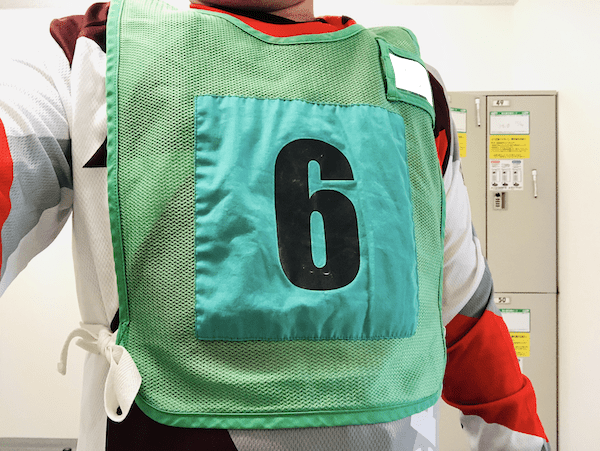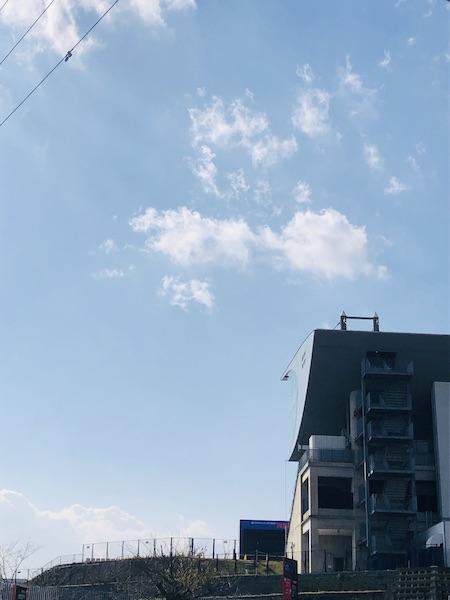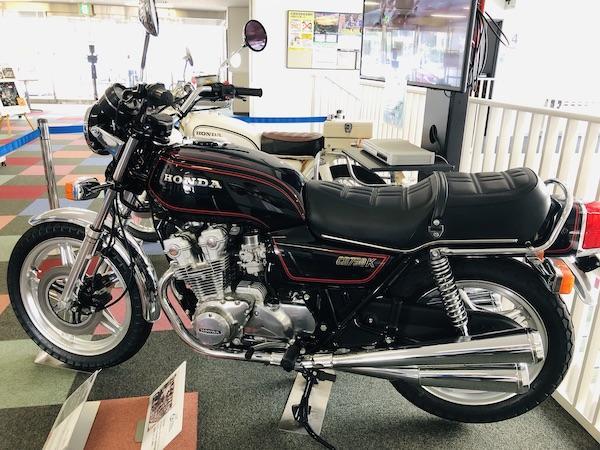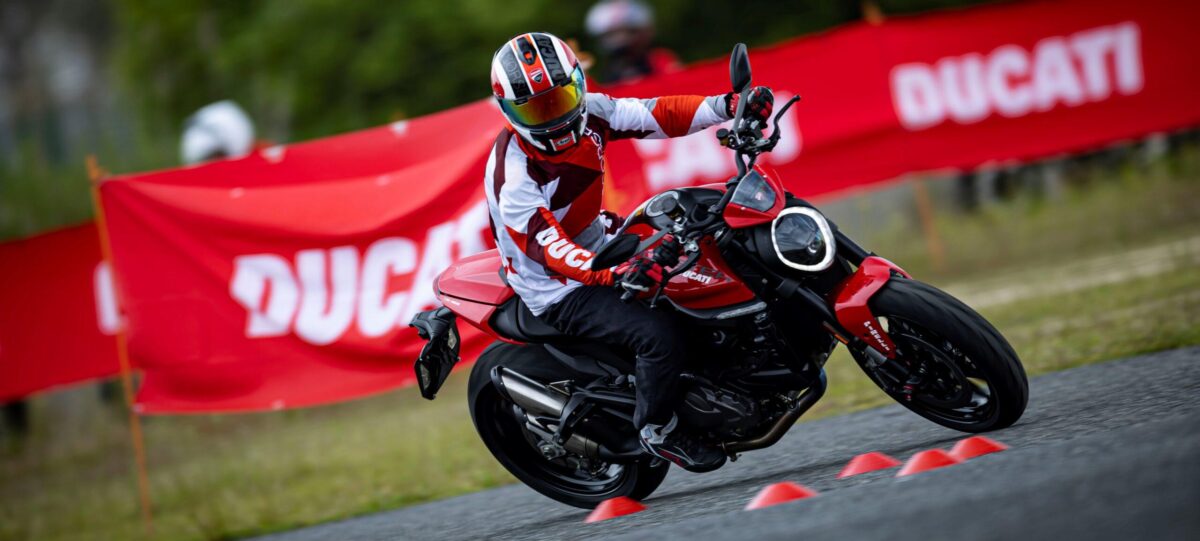Today is the day before qualifying for the MFJ Grand Prix.
It’s the second day of the unofficial sessions.
A roar is echoing from the circuit.
This time, the class size is small.
Let’s make sure we get some good practice.
Orientation
Today, we had a small group “Intermediate Sporty Ride Challenge Course”.
There were seven participants.
Some of them were very experienced.
There was no driving lesson,
and this was the only lesson for today,
so it wasn’t as lively as usual.
When we had a small group,
there was only one instructor,
but this time there were two.
I wonder if the main instructor was a newcomer this year?
The supporting instructor was the main instructor from last time.
Yes, he knew about my fall.
The goal for this time was to “be conscious of forward and backward movement!”,
based on the points to be careful of last time.
The rest of the lesson was to try to ride carefully,
without aiming for speed.
After a quick orientation,
we started preparations.

Warming up
The bike I used was a CB400SF, as usual.
But I managed to avoid the bike that had flipped over before.
At least (lol).
During the first half of the warm-up,
I noticed that the engine warning light was still on,
so I changed bikes.
The bike I got instead was
the bike that had flipped over before.
(It was you after all!)
I continued warming up.
This time, I started from the warm-up,
because I was conscious of my forward and backward movements.
(Last time’s comment: You were slow to assume an accelerating position.)
But the handling of the bike…
It had a lot of self-steering.
(Probably because the tires were well-used.)
I knocked over some pylons in narrow places,
and I thought, Ah, I’m not feeling well today either!。
Thorough warm-up on the S-curve course.
Practice smooth acceleration operation.
I practiced throttle work so that when I lightly open the throttle and exit a corner, I don’t accelerate suddenly.
I had done this the weekend before, when I rode my bike for the first time in a while,
so here I was able to operate and accelerate relatively smoothly.
As soon as you release the throttle, take up the play immediately!
Driving with one hand
Following this, I drove the S-curve course with one hand.
When accelerating, my body gets left behind,
and I can’t move forward or backward.
Sometimes I open the throttle too much, which is a surprise!
After a while, I realized that my knee grip was weak,
and improved by gripping it tighter.
(Until now, I’d been holding on to the handlebars.)
This may have been one of the reasons for my last fall.
This time, I realized something during the warm-up.
Braking practice
There are two patterns: accelerating in first gear and braking at the target,
and shifting up to second gear and braking at the target.
As expected, releasing the brake is difficult.
This time, I also tried shifting down from second gear,
but I think I should practice focusing on just braking.
Practicing turns
His body movements still seem to be poor, so
we start slowly.
First, we check the line that will take you behind the pylon.
Since the class is small, we can run a lot and try out a lot of different things.
We tried changing the amount of front brake left and its strength,
while also varying the strength of the rear brake.
It seems like we can still apply more pressure on the rear brake.
I think I was able to operate the accelerator more smoothly than usual when starting out.
We ended the morning with things looking a little better.
Lunch break
The next day, the “MFJ All Japan Road Race Championship Series 2022 Round 8”
I couldn’t get into the grandstand.

Slalom practice
A full lap of the course, a straight pylon slalom, an offset slalom,
and randomly placed pylons,
which I haven’t seen in a while,
was the slalom course this time.
Straight Pylon Slalom
I was trying hard to practice my forward and backward movements in slalom, but I didn’t quite get it and was struggling when the instructor stopped me from behind.
He said I was going too straight and told me to “imagine running in a zigzag pattern.”
I kept doing straight pylon slalom for a while, but it seems like it’ll be a while before I get the hang of it.
I hadn’t really taken slalom seriously until now, so this is where I paid the price.
I now understand that straight pylon slalom has many different elements.
Offset Slalom
I love offset slalom, but even here, I didn’t increase my pace and focused on moving my body back and forth and switching sides.
In the morning practice, I learned that I could press the rear brake more, so when I applied the rear brake firmly here, I felt like I could turn more compactly than usual.
I forgot when we were talking about it, but it’s important to have a good knee grip and lean the bike over.
I think we were talking about that.
With that in mind, I tried to turn as hard as I could.
(I’m not sure if I’m turning though)
Random Slalom
You run between randomly placed pylons,
but right after the start you make a 90 degree left turn from four straight pylons.
Then you make a right U-turn.
A firm knee grip was useful for this 90 degree left and right U-turn.
I felt a sense of connection in this lesson.
Figure 8
A figure 8 was made in one place along the course.
It’s a common pattern where anyone who wants to run can run.
The pylons are spaced at least 10m apart.
You can accelerate well between the pylons.
Again, I tried to run while being conscious of my body movements and
putting my rear brake on firmly.
Course Slalom
It was course slalom, but maybe because I had worked hard on pylon slalom,
my back hurt and I was tired in a different way than usual.
Is this because I was able to use my body better?
There wasn’t much advice for this lesson,
but I felt like I was on the ball.
Speed isn’t required for course slalom either.
Anyway, I’ll try to make smooth turns and remember to move forward and backward.
Because I think the left side of the rear wheel is slippery
Before the start, I received some great advice.
“Because I think the left side of the rear wheel is slippery.”
Wow!
I tried a few runs, and it seemed like I could switch from left to right smoothly.
Even when making small turns, I used a firm knee grip, and tried not to forget to change direction all at once.
I tried to increase my pace.
I sometimes heard a crackling sound from the engine, like an afterfire.
It seemed like the engine was running faster than usual.
Sometimes I couldn’t slow down in time and I almost jumped out.
There were times when the rear wheel also slid and I broke out in a cold sweat.
You’re starting to move forward and backward too!
The instructor watching from behind said,
“You’re starting to move forward and backward too.”
However, it’s too much forward and backward,
so it would be good to have some diagonal movement.
He said that slalom movement is important here.
(Still using the D-pad movement. See #16 for what this means.)
After the final break,
the other instructor followed us.
Your body is moving well too.
And so, we finished on a good note!
Summary
This time, it was only two weeks since the last time, and the class size was small, so I was able to try out a lot of things using the advice from the last time.
For a while, I’m going to focus on my body movements and practice slaloms and small turns.
The problem is that it’s hard to do it on my car.



